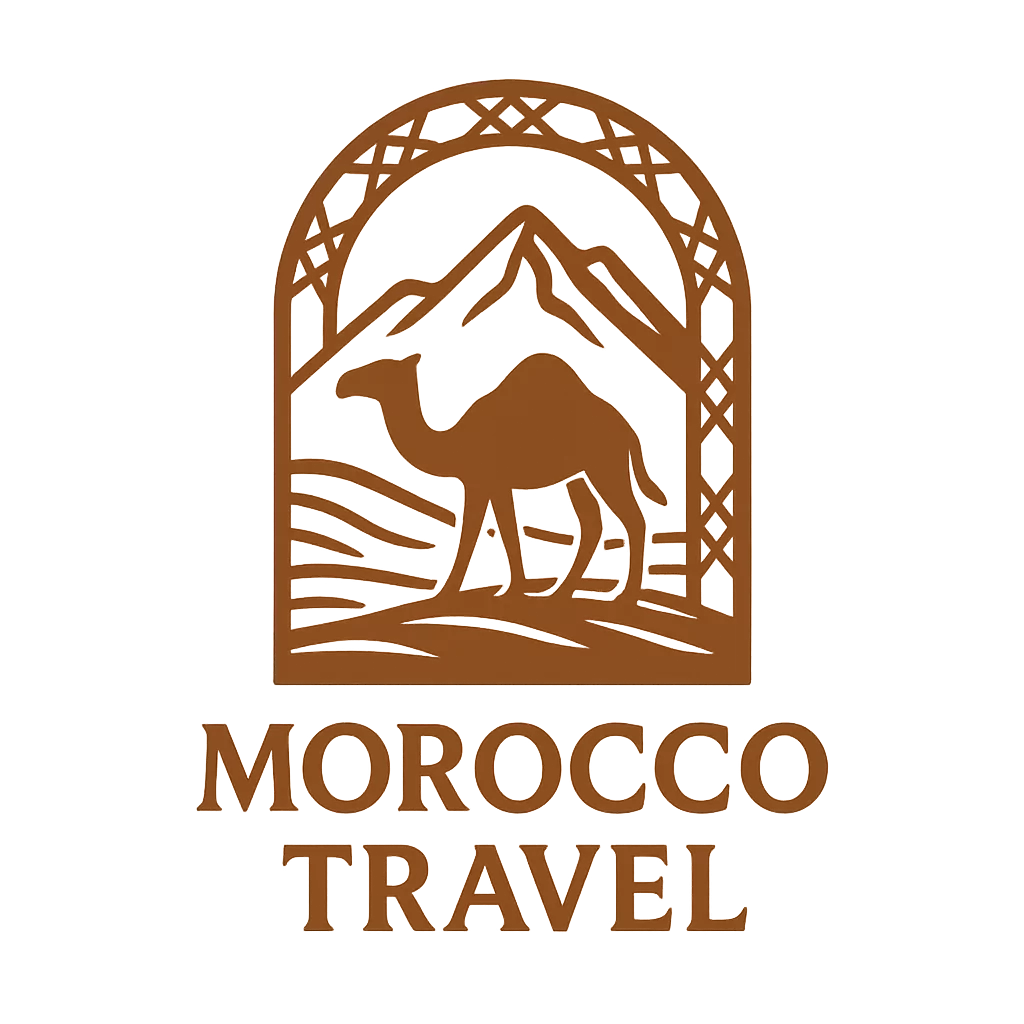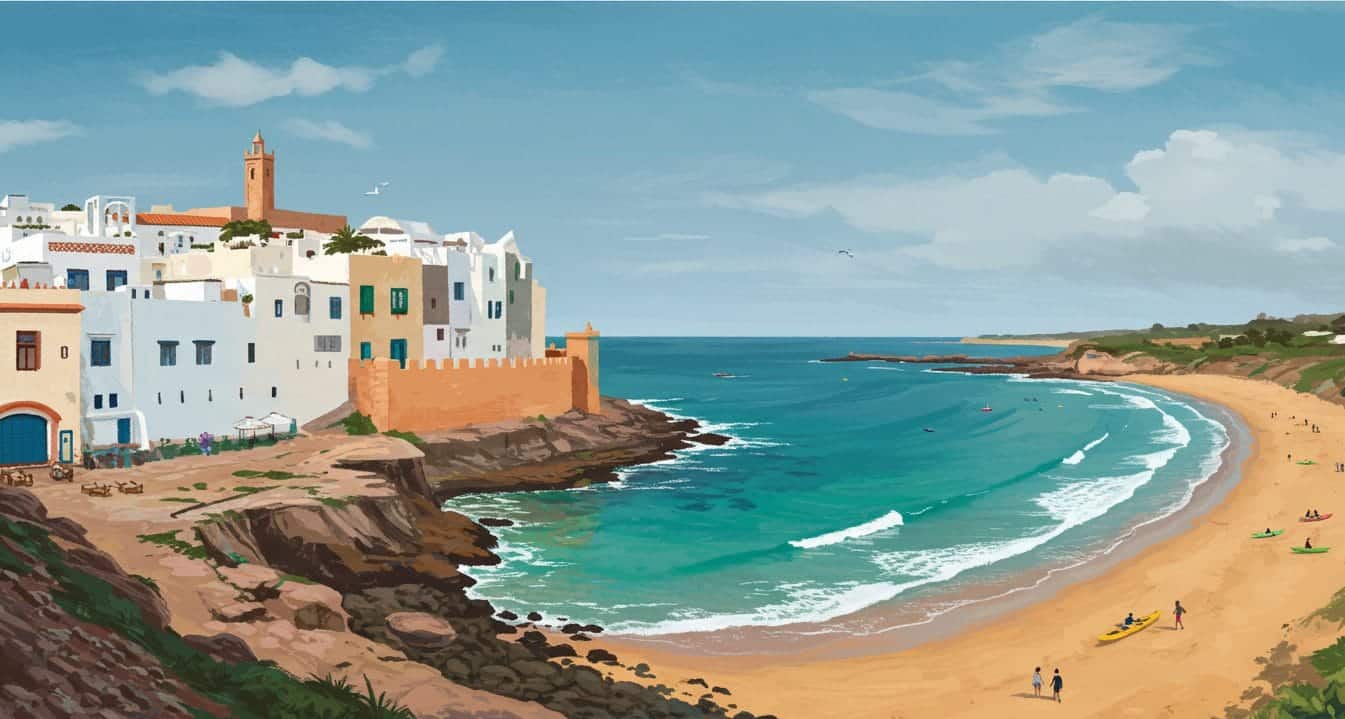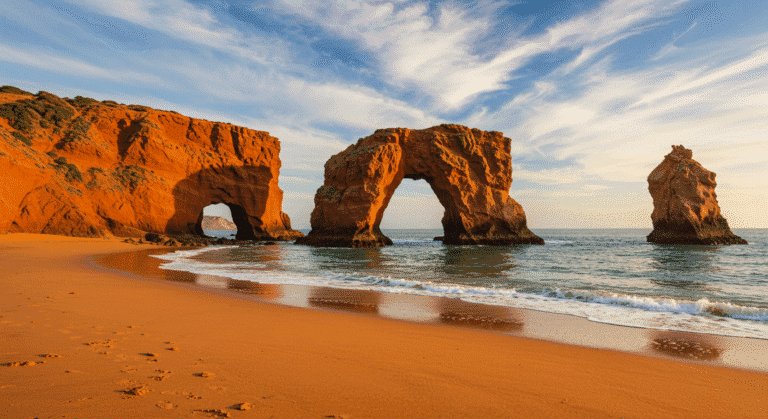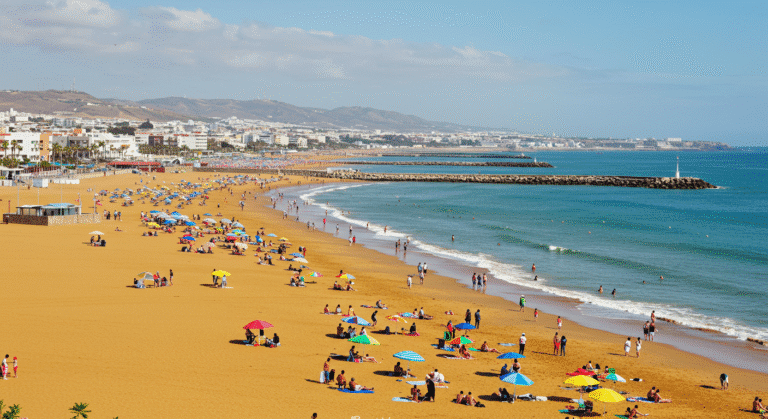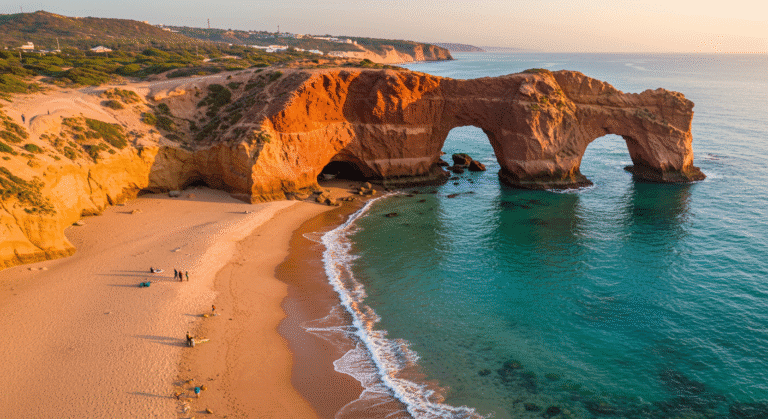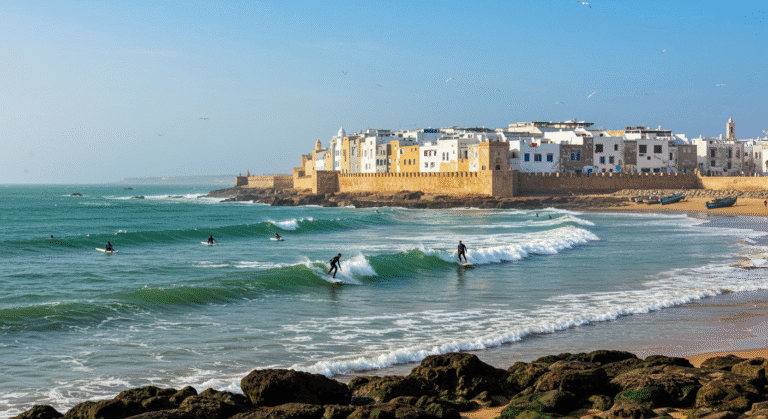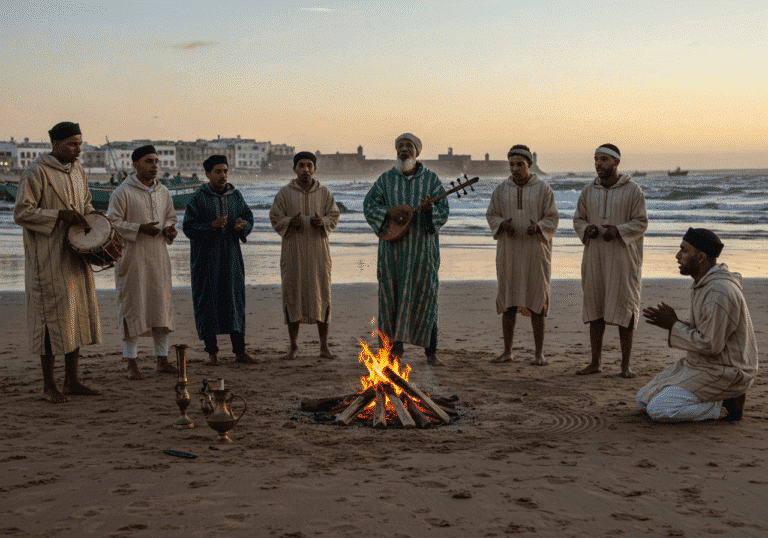Morocco Beach & Surf: 8-Day Atlantic Coast Itinerary”
Introduction
Did you know that Morocco’s Atlantic coastline stretches over 1,835 kilometers, yet remains one of Africa’s most underexplored beach destinations? While millions flock to Mediterranean hotspots, savvy travelers are discovering that Morocco beach experiences offer something extraordinary: world-class surf breaks, pristine sandy shores, and authentic Berber coastal culture at a fraction of European prices. From the cosmopolitan beaches of Casablanca to the bohemian surf towns of Taghazout, Morocco’s Atlantic coast delivers an intoxicating blend of adventure and relaxation that challenges every preconception about North African travel.
This comprehensive 8-day Morocco beach itinerary unveils hidden coastal gems, provides insider surf spot recommendations, and shares practical tips gathered from dozens of Atlantic coast adventures. Whether you’re chasing perfect waves, seeking sun-soaked relaxation, or craving cultural immersion with ocean views, this guide transforms your Moroccan coastal dreams into actionable travel plans.
Travel Checklist / What to Pack
Essential Beach & Surf Gear
- Wetsuit (3mm minimum): Atlantic waters range 16-22°C year-round
- Reef-safe sunscreen SPF 50+: Moroccan sun intensity peaks at UV Index 11
- Quick-dry board shorts/bikinis: Pack 3-4 sets for daily beach activities
- Waterproof phone case: Essential for capturing Instagram-worthy surf shots
- Beach towel (microfiber): Sand-resistant and quick-drying
Cultural Respect Items
- Modest cover-ups: Long-sleeved shirts for mosque visits and conservative areas
- Lightweight pants: Linen or cotton for evening coastal walks
- Comfortable walking shoes: For exploring medinas and rocky coastlines
- Sunhat with chin strap: Coastal winds can be surprisingly strong
Pro Travel Tips
- Portable charger: Beach days drain batteries quickly
- Waterproof dry bag: Protects valuables during surf sessions
- Argan oil: Local skincare secret for sun-damaged skin
- French phrasebook: Helpful in coastal towns beyond tourist areas
- Reusable water bottle: Stay hydrated while reducing plastic waste
Best Time to Visit
Peak Season Analysis
April-June & September-October offer the sweet spot for Morocco beach vacations. During these months, air temperatures hover between 22-26°C while water temperatures reach comfortable 19-21°C. Tourist crowds decrease by 40% compared to European summer holidays, translating to better accommodation rates and less crowded beaches.
Seasonal Breakdown
Spring (March-May): Ideal for surfing with consistent Atlantic swells and mild temperatures. Accommodation costs drop 25% compared to summer peaks.
Summer (June-August): Perfect for families seeking warm weather and calm waters. Expect 30% higher prices and crowded beaches in Agadir and Casablanca.
Autumn (September-November): Premium surfing conditions with offshore winds and larger swells. Water temperatures remain warm from summer heating.
Winter (December-February): Serious surfers’ paradise with powerful Atlantic storms generating world-class waves. Air temperatures average 18°C, requiring wetsuits for comfort.
Cultural Calendar Highlights
- Gnawa Music Festival (June): Essaouira transforms into Morocco’s musical epicenter
- Marathon des Sables (April): Witness ultra-runners crossing desert landscapes
- Ramadan considerations: Restaurant hours and cultural activities may vary
Step-by-Step Itinerary
Day 1: Casablanca Coastal Welcome
Morning: Arrive at Mohammed V International Airport and transfer to coastal accommodations. Start your Morocco beach adventure at Ain Diab Beach, Casablanca’s premier sandy stretch. This 3-kilometer beach offers gentle waves perfect for first-time surfers and numerous beach clubs serving fresh seafood.
Afternoon: Explore the Hassan II Mosque, one of the world’s largest mosques with stunning Atlantic Ocean views. The guided tour reveals architectural marvels and provides cultural context for your coastal journey.
Evening: Dine at La Sqala, a restaurant built into 18th-century fortifications overlooking the ocean. Try their signature pastilla while watching sunset paint the Atlantic golden.
Day 2: Rabat’s Royal Coastline
Morning: Take the 1-hour train to Rabat (cost: 30 MAD). Visit Plage de Rabat, a local favorite with consistent surf breaks and fewer tourists than Casablanca beaches.
Afternoon: Explore the Kasbah of the Udayas, a UNESCO World Heritage site with panoramic ocean views and traditional blue-and-white architecture. The adjacent Andalusian Gardens provide peaceful respite from coastal winds.
Evening: Experience authentic Moroccan hospitality at a local riad. Sample chermoula-grilled fish while planning tomorrow’s surf adventure.
Day 3-4: El Jadida’s Portuguese Legacy
Day 3 Morning: Drive 2 hours south to El Jadida (rental car recommended for coastal flexibility). Check into beachfront accommodations and explore Plage El Jadida, known for kitesurfing and windsurfing opportunities.
Day 3 Afternoon: Discover the Portuguese City, a 16th-century fortress showcasing unique Moroccan-European architecture. The underground cistern creates hauntingly beautiful photo opportunities.
Day 4: Dedicate this day to water sports and beach relaxation. Sidi Bouzid Beach offers excellent surfing conditions with several local surf schools providing equipment and instruction.
Day 5-6: Essaouira’s Bohemian Charm
Day 5: Journey to Essaouira (2.5-hour drive), Morocco’s windsurf capital. Check into a traditional riad within the medina walls. Afternoon exploration of Plage d’Essaouira reveals consistent trade winds perfect for wind sports.
Day 6: Full day devoted to Essaouira’s cultural treasures. Morning visit to Skala de la Ville for historic cannon views and artisan workshops. Afternoon surf lesson at Sidi Kaouki Beach, 25 kilometers south, offering powerful waves and stunning scenery.
Day 7-8: Agadir’s Resort Paradise
Day 7: Drive 3 hours to Agadir, Morocco’s premier beach resort destination. Agadir Beach stretches 10 kilometers with golden sand and modern amenities. Afternoon relaxation and water sports exploration.
Day 8: Final day combines adventure and culture. Morning visit to Paradise Valley, a hidden oasis 1 hour inland with natural pools and palm trees. Afternoon departure preparations and last-minute souvenir shopping in Agadir’s modern souks.
Budget Breakdown
Accommodation Costs (per night, double occupancy)
- Budget Options: Hostels and basic riads (200-400 MAD / $20-40)
- Mid-Range: Boutique riads and beach hotels (600-1,200 MAD / $60-120)
- Luxury: Ocean-view resorts and premium riads (1,500-3,000 MAD / $150-300)
Transportation Budget
- Rental Car: 300-500 MAD/day ($30-50) – recommended for coastal flexibility
- Train (Casablanca-Rabat): 30 MAD ($3) one-way
- Intercity Buses: 80-150 MAD ($8-15) between major coastal cities
- Local Taxis: 10-50 MAD ($1-5) for short distances
Food & Dining
- Street Food: 20-40 MAD ($2-4) per meal
- Local Restaurants: 60-120 MAD ($6-12) per person
- Tourist Restaurants: 150-300 MAD ($15-30) per person
- Beach Clubs: 200-500 MAD ($20-50) per person with drinks
Activity Costs
- Surf Lesson: 200-300 MAD ($20-30) including board rental
- Kitesurfing Course: 400-600 MAD ($40-60) per session
- Hammam Experience: 100-200 MAD ($10-20)
- Guided Tours: 300-500 MAD ($30-50) per person
Total 8-Day Budget Estimate:
- Backpacker: $400-600 per person
- Mid-Range: $800-1,200 per person
- Luxury: $1,500-2,500 per person
Sustainable & Cultural Alternatives
Eco-Friendly Beach Experiences
Cooperative-Based Tourism: Support local women’s argan oil cooperatives near Essaouira. These initiatives provide fair wages while preserving traditional production methods and environmental conservation.
Plastic-Free Beach Days: Join local cleanup initiatives in Agadir and Casablanca. Several organizations organize weekly beach cleanups that combine environmental action with cultural exchange.
Sustainable Surf Schools: Choose operators using eco-friendly boards and promoting ocean conservation. Surf Berbère in Taghazout leads sustainable surfing practices while employing local instructors.
Family-Friendly Alternatives
Cultural Workshops: Participate in traditional pottery classes in Safi or carpet weaving demonstrations in coastal villages. These hands-on experiences engage children while supporting local artisans.
Camel Beach Rides: Gentle camel excursions along Agadir’s coastline provide family adventure without overwhelming young travelers.
Solo Traveler & Digital Nomad Options
Coworking Spaces: Essaouira and Agadir offer growing digital nomad communities with reliable internet and beachfront workspaces. The Spot Essaouira combines coworking with surf culture.
Women-Only Riads: Several coastal accommodations cater specifically to female solo travelers, providing safe spaces with cultural immersion opportunities.
Food & Dining Suggestions
Must-Try Coastal Cuisine
Fresh Sardines at Essaouira Port: Watch fishermen unload daily catches while grilling happens steps away. The smoky aroma mingles with Atlantic salt air, creating an unforgettable sensory experience.
Seafood Pastilla in Casablanca: This delicate pastry filled with shrimp, fish, and vermicelli challenges preconceptions about Moroccan cuisine. Best enjoyed at Restaurant Al Mounia with ocean views.
Argan Oil Tastings: Visit coastal cooperatives producing this liquid gold. The nutty flavor profile pairs perfectly with fresh bread and honey while supporting women’s economic empowerment.
Hidden Culinary Gems
Café Hafa, Tangier: This clifftop café served as inspiration for Beat Generation writers. Mint tea tastes extraordinary while watching Atlantic waves crash below.
Fish Market, Agadir: Purchase fresh catches and have them grilled at adjacent stalls. Choose your fish, specify preparation, and enjoy restaurant-quality meals at street food prices.
Sunset Dining Experiences
La Plage Rouge, Casablanca: Toes-in-sand dining with contemporary Moroccan fusion cuisine. Reservations essential for sunset tables.
Taros, Essaouira: Rooftop restaurant serving traditional tagines with panoramic medina and ocean views. The rooftop bar transforms into cultural entertainment venue after dark.
Common Mistakes to Avoid
Booking & Planning Errors
Underestimating Travel Distances: Morocco’s coastal roads wind through mountains and small villages. Always add 30% extra time to GPS estimates for realistic travel planning.
Ignoring Tide Charts: Many beaches become dangerous during high tide. Download local tide apps and check conditions before surfing or swimming.
Overlooking Friday Prayer Times: Restaurants and attractions may close during Friday prayers (12:00-14:00). Plan alternative activities or embrace the cultural pause.
Cultural Sensitivity Mistakes
Inappropriate Beach Attire: While bikinis are acceptable on tourist beaches, cover-ups show respect when walking through towns or visiting local areas.
Haggling Aggressively: Coastal vendors expect negotiation, but maintaining friendly demeanor ensures better prices and cultural exchange.
Photographing Without Permission: Always ask before photographing locals, especially women and children. Respect creates meaningful connections.
Safety & Practical Oversights
Neglecting Travel Insurance: Ocean activities carry inherent risks. Comprehensive coverage including water sports activities provides essential protection.
Carrying Excessive Cash: Use ATMs in major cities and keep daily spending money separate from emergency funds.
Ignoring Local Weather Patterns: Coastal winds intensify afternoon. Plan beach activities during calmer morning hours for optimal comfort.
Safety & Travel Tips
Ocean Safety Guidelines
Rip Current Awareness: Morocco’s Atlantic coast generates powerful rip currents. Learn identification techniques and escape strategies before entering water.
Surf Etiquette: Respect local surf breaks and experienced surfers. Beginners should use designated learning areas to avoid conflicts and injuries.
Jellyfish Seasons: Portuguese man o’ war occasionally wash ashore during autumn months. Check with lifeguards and locals before swimming.
Personal Security Measures
Accommodation Security: Use hotel safes for passports and excess cash. Carry photocopies of important documents separately.
Transportation Safety: Choose reputable car rental companies with comprehensive insurance. Avoid driving at night on coastal mountain roads.
Emergency Contacts: Save local emergency numbers (Police: 19, Medical: 15) and your embassy contact information.
Practical Communication Tips
SIM Card Options: Maroc Telecom and Orange Morocco offer tourist packages with good coastal coverage. Purchase at airports or official stores.
Language Preparation: Download offline translation apps. French proves more useful than English in coastal regions outside major tourist areas.
Money Matters: ATMs are widely available in cities but scarce in small coastal villages. Carry emergency cash reserves.
Health Considerations
Water Safety: Stick to bottled water, especially in smaller coastal towns. Ice in tourist establishments is generally safe.
Sun Protection: Moroccan sun combined with ocean reflection creates intense UV exposure. Reapply sunscreen every 2 hours, even on cloudy days.
Conclusion
Morocco’s Atlantic coast offers an extraordinary blend of authentic culture, pristine beaches, and world-class surfing that rivals any Mediterranean destination at half the cost. This 8-day itinerary unveils hidden gems from Casablanca’s urban beaches to Essaouira’s bohemian surf culture, providing memories that extend far beyond typical beach vacations. The combination of consistent waves, warm hospitality, and rich cultural experiences creates travel stories worth sharing for years.
Ready to experience Morocco’s coastal magic firsthand? Share your own Moroccan beach adventures in the comments below, subscribe for more hidden destination guides, and download our complete Morocco travel checklist to ensure your Atlantic coast adventure exceeds every expectation.
FAQs
Do I need a visa to visit Morocco for beach holidays?
Citizens of most Western countries receive automatic 90-day tourist visas upon arrival. Ensure your passport has 6 months validity remaining and blank pages for entry stamps.
What’s the appropriate dress code for Morocco beaches?
Bikinis and swimwear are acceptable on tourist beaches and hotel pools. Cover-ups are recommended when walking through towns or visiting local areas. Men should wear shirts when leaving beach areas.
Is it safe for solo female travelers on Morocco’s coast?
Yes, with reasonable precautions. Coastal tourist areas are generally safe, and many accommodations cater specifically to solo female travelers. Avoid isolated beaches after dark and trust your instincts in social situations.
Can I drink alcohol at Morocco beach resorts?
Licensed hotels, restaurants, and tourist establishments serve alcohol. Local beach clubs and international hotels offer full bar service. Alcohol is not available in local neighborhoods or traditional restaurants.
What currency should I bring to Morocco?
The Moroccan Dirham (MAD) is the only accepted currency. Credit cards work in major establishments, but carry cash for local markets, taxis, and small businesses. ATMs are readily available in coastal cities.
How’s the internet connectivity for digital nomads on Morocco’s coast?
Major cities like Casablanca, Rabat, and Agadir offer reliable 4G coverage and fiber internet. Essaouira and smaller coastal towns provide adequate connectivity for remote work, with several coworking spaces available.
What’s the best way to book surf lessons on Morocco’s coast?
Book directly with certified surf schools upon arrival for better prices and flexibility. Popular spots like Taghazout and Essaouira offer numerous options. Always verify instructor certifications and equipment quality before committing to multi-day packages.
